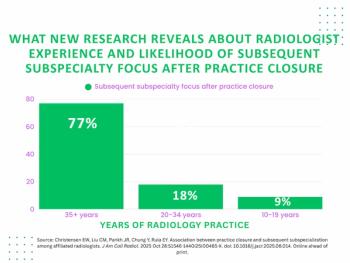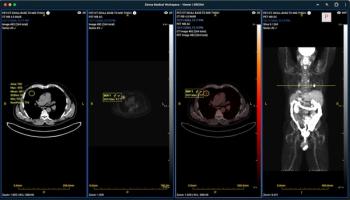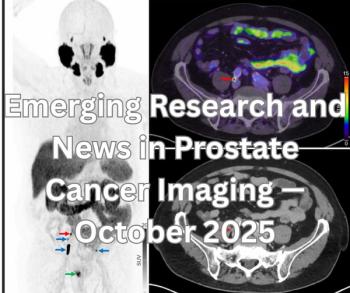Emerging computed tomography (CFT) and magnetic resonance imaging (MRI) research suggests that LR-M lesions are over 50 and 40 percent more likely than LR-4 lesions and LR-5 lesions, respectively, to be associated with rapid progression of early-stage hepatocellular carcinoma (HCC).
For the retrospective study, recently published in Radiology, researchers reviewed baseline CT and MRI data as well as gadoxetate-enhanced MRI exams for 322 patients (mean age of 61) with a total of 345 HCC cases. Utilizing the Liver Imaging Reporting and Data System (LI-RADS) categories, the study authors noted the HCC cases were comprised of 221l LR-5 lesions, 64 LR-4 lesions, 30 LR-3 lesions and 30 LR-M lesions. The median tumor volume doubling time (TVDT) was 131 days and 27 percent of the reviewed HCCs exhibited rapid growth, according to the study.
The researchers found that 70 percent of LR-M lesions exhibited rapid progression in contrast to 28.5 percent of LR-5 lesions, 12.5 percent of LR-4 lesions and 3.3 percent of LR-3 lesions.
Patients with LR-M lesions also had a shorter tumor volume doubling time (TVDT) (79 days) in comparison to those with LR-5 lesions (125 days), LR-4 lesions (149 days) and LR-3 lesions (170 days), according to the study authors. The researchers also pointed out that the presence of LR-M lesions was associated with over a ninefold greater risk of rapid HCC growth.
“Since treatment decisions or follow-up intervals might differ according to the degree of HCC growth, patients with HCCs predicted to have rapid growth might need expedited treatment or shorter follow-up intervals and tailored bridging local-regional therapy while waiting for liver transplant,” wrote lead study author Hyeon Ji Jang, M.D., who is associated with the Department of Radiology and Research Institute of Radiology at the University of Ulsan College of Medicine and the Asan Medical Center in Seoul, South Korea, and colleagues.
While the majority of LR-M lesions are non-HCC malignancies, the researchers cautioned that over a third of these lesions are atypical HCCs, noting challenges with the detection of progenitor-type HCCs as well as changes that occur with hepatocarcinogenesis.
“During hepatocarcinogenesis, the arterial blood supply decreases when a moderately differentiated HCC progresses to a poorly differentiated HCC; therefore, a non-enhanced area within the tumor at arterial phase imaging is more frequently observed in poorly differentiated HCCs than in well-differentiated or moderately differentiated HCCs,” explained Jang and colleagues. “Furthermore, some LR-M lesions may be progenitor-type HCCs expressing stem cell markers originating from cholangiocytes, which are associated with abundant stromal elements.”
Three Key Takeaways
1, LR-M lesions and rapid HCC progression. LR-M lesions are significantly more likely to exhibit rapid progression compared to LR-4 and LR-5 lesions, with 70 percent of LR-M lesions showing rapid growth. These lesions are associated with shorter tumor volume doubling times (79 days) and a ninefold higher risk of rapid HCC progression.
2. Use of α-fetoprotein as a prognostic marker. Patients with α-fetoprotein levels exceeding 400 ng/mL have over a 2.5-fold increased risk of rapid HCC growth. Higher levels are linked to poorly differentiated HCC, recurrence, and worse prognosis after treatment.
3. Implications for treatment and follow-up. Rapidly growing HCCs, particularly LR-M lesions, may necessitate expedited treatment, shorter follow-up intervals, and tailored bridging therapies while patient are awaiting liver transplantation. Enhanced monitoring is critical for these high-risk patients.
The study authors also noted that patients with an α-fetoprotein level > 400 ng/mL had over a 2.5-fold higher risk for rapid HCC growth.
“ … The serum α-fetoprotein level has been reported to be higher in poorly differentiated HCC than in well-differentiated or moderately differentiated HCC, and to be a significant predictor of recurrence and prognosis after treatment,” added Jang and colleagues.
(Editor’s note: For related content, see “Comparative Study Says Enhanced MRI Offers Optimal Detection of Neuroendocrine Tumor Liver Metastases,” “Deep Learning Model with DCE-MRI May Help Predict Proliferative Hepatocellular Carcinoma” and “Can Multiparametric Ultrasound Enhance Detection of Metabolic Dysfunction-Associated Steatohepatitis (MASH)?”)
Beyond the inherent limitations of a single-center retrospective study, the authors noted possible patient selection bias, and that CT was utilized for baseline exams for over 85 percent of the cohort despite MRI having better lesion-to-liver contrast resolution.

































